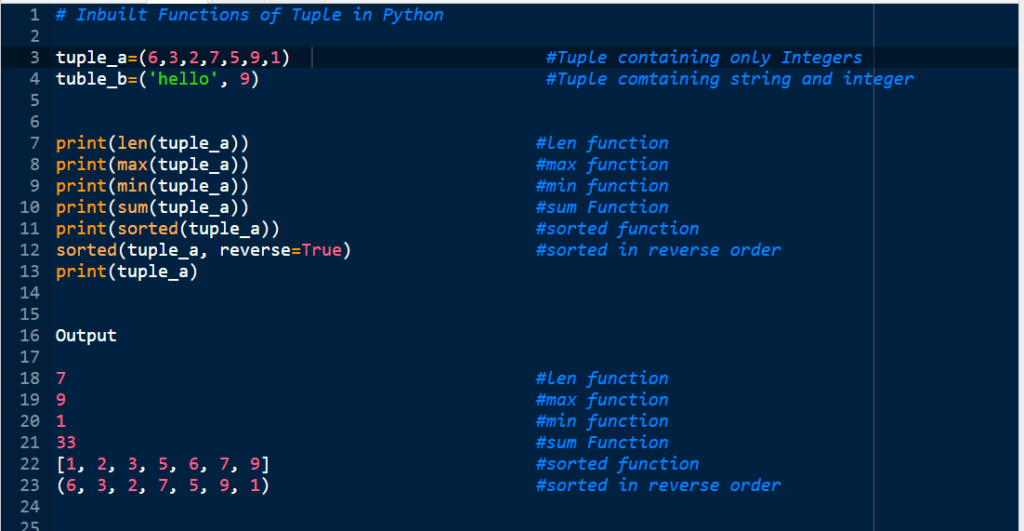Students use to search for python what is a tuple, and it works. As we all know, Python is fast expanding in popularity due to the attention of students and programmers. Python programming language is a multi-purpose coding language that may be used for a variety of purposes.
Some of the uses of python are in web development, artificial intelligence, machine learning, operating systems, mobile app development, and video game creation. Statisticians use python for machine learning and data science. Python’s syntactic simplicity makes it easy for programmers to create various software with the language. In this blog, we’ll look at, Python what is a tuple is and how it works.
In Python What Is a Tuple?
Table of Contents
A tuple, like a list, is a collection of Python objects. Tuples and lists differ because tuples cannot be altered, although lists may, and tuples use parentheses while lists use square brackets. Integers index the sequence of values contained in a tuple, which can be of any type. ‘Commas’ are used to separate the values of a tuple in python. Although it is not required, it is more typical to close the sequence of values in parentheses when forming a tuple in python, making it easier to understand Python tuples.
In Python, a tuple allows you to keep a list of items in a specific order. For Example, A tuple can store a list of student names and hold a list of chocolate varieties available in a store. There are various uses of a tuple in python. A tuple is one of Python’s 4 built-in data types for storing data collections; the other three are List, Set, and Dictionary, all of which have different properties and applications. Let’s discuss in python what is a tuple or tuple in python and its functions.
How To Create A Tuple In Python
A tuple is formed by including all items (elements) in parenthesis () and separating them with commas. The parentheses are not required. It is, nonetheless, a good idea to employ them. There can be any number of components in a tuple, and they can be of various types (integer, float, list, string, etc.).
How to Create a tuple in python:
There is a basic way of declaring tuple. In python what is a tuple and how it can be declared by using the tuple function? let us try to understand by taking an example.
tuple_name=(1,2,3,4,5) #this tuple contain element 1,2,3,4,5
A comma after an element can be used to form a tuple in Python containing a single element. We’ve specified two tuples in this case. The first is without a comma, whereas the second is with a comma. When we verify the data type, the declaration without the comma is considered a string type. In contrast, the declaration with the comma is regarded as a tuple, as shown in the image below. As seen in the image
Built-in Functions of a Tuple in python
- len()
len() function is used to count the no. of elements present in the tuple. We have mentioned below in figure how it works.
- max()
The max () function is used to find the tuple’s highest number. If you include a string in a tuple, the result will be shown using the ASCII table.
- min()
The min() function is used to find out the smallest number present in a tuple
- sum()
The sum() function is used to check out the sum of all the digits present in a tuple.
- sorted()
The sorted() method can be used in a variety of ways. Sorting a tuple involves arranging it in ascending or descending order. Programmers use simple functions to do numerous tasks.

- any()
The outcome of any() function is displayed as true or false. This function will return True if any type of element is present in the list. If there isn’t any element present, the outcome will be false.
- all()
This function will examine all of the values included in a tuple. If a blank element is encountered, the output will be false. The list must contain all of the values, and if the value is null, the outcome will be false.
Inbuilt operations on tuples in python
- In()
The in() function is used to determine whether or not an element is present in the tuple. You must use this function and enter the element you want to examine, as indicated in the image. If the element is present, this method will return true as an output. If this is not the case, the function will return false.
- Not in()
This function returns the inverse of the in() function. However, this function is used by a variety of programmers. If the element is missing from the tuple, the output will be true, and if the element is present, the output will be false.
Let us discuss inbuilt methods of Tuples in python
There are mainly 2 inbuilt methods of tuples they are:
- index()
As you may know, when any element is stored in memory, the index starts at 0. The function index() is used to check the position of any element in the tuple. As an example,
(tuple_a.index(2))
Here tuple_a is the name of tuple
index()is the function
2 is the element that we want to search in tuple_a.
- count()
count() function allows you to check how many times a single element is used in a tuple. We can also say that this function is used to verify the presence of a number in a tuple. For example
print(tuple_a.count(6)
Here tuple_a= name of tuple
count() is a function
6 is the element that we want to check. As shown in the image.
The inbuilt operation used to operate tuple in python
Concatenation
The tuples are combined using the Concatenation function. For example, if you wish to combine two tuples into a single tuple, you can use the concatenation function. There are two tuples in the image, tuple a and tuple b. These tuples have been concatenated into c. for this. We use the operator ‘+.’ As shown in the below image.
Slicing
Using the slicing operator colon, we can get a list of things in a tuple in python. The best way to conceptualize slicing is to see the index between the elements, as shown below. So, if we wish to access a range, we’ll require the index that slices the tuple into slices.
Deletion of a tuple
As previously stated, we can’t change the elements in a tuple. Hence we can’t delete or remove items from a tuple. However, we can use the del() function to delete a tuple in python completely.
Python: Tuple vs List
- When comparing a tuple to a list, you may have heard that a list is mutable, while tuples in Python are not. Let’s define what those mutable terms mean. Basically, in a list, we can figure out a simple way to change the values between them, but in a tuple, we don’t have that option to modify the value of an element within the tuple.
- When creating a list in python, we use [] these square brackets to enter values in a list. But inserting values in a tuple in python can be done inside the () small brackets or round brackets.
- So the question arises here: why do programmers use tuples in python even when they wouldn’t be able to change their values inside the tuples? Since we don’t change the values in a tuple in python so that the iteration can be done much faster, programmers used to use tuple in python to store values. So that is the reason the programmer used tuples instead of lists to enhance the speed of execution.
- When comparing lists and tuples in Python, the list takes up more space. To demonstrate this, consider the following scenario. After constructing a list and a tuple, we’ll fill them with the same values or elements and compare their sizes. Let us take an example to show the size of tuple in python vs list in python.
Also Read..!!
- Python Vs SQL: Points You Need to Know About Python and SQL
- Top Python Packages for Data Science in 2021 You Must Know
- Flask vs Django: Which Framework is Better for beginners
Conclusion
In addition to learning about Python what is a tuple, we also learned about the many functions and operations performed on a tuple in Python and the differences between a list and a tuple in Python. We hope you have learned all of the concepts described above and that you have a thorough understanding of them. We’re here to supply you with various blogs on programming, statistics, and a variety of other topics, so stay in touch with us for more learning.
We have a team of experts who provide python homework help service. If you need any assistance, don’t hesitate to contact us. Our experts have years of experience they can assist you properly.
FAQ’s Frequently Asked Questions
What are the benefits of Python tuples?
Tuples are used when you want a function to produce several results. They can be used as keys for a dictionary because they’re immutable (lists can’t).
Where do tuples come into play in real life?
Because a tuple always has a specified amount of elements, you can use it to store your home’s latitude and longitude (in this specific example, two). The coordinates of other locations can be stored using the same Tuple type.


